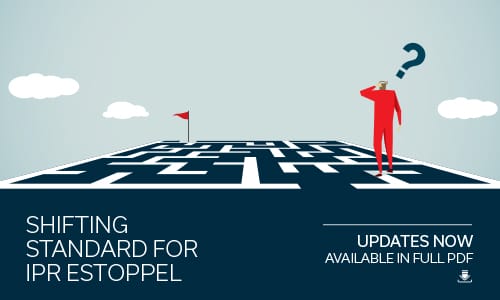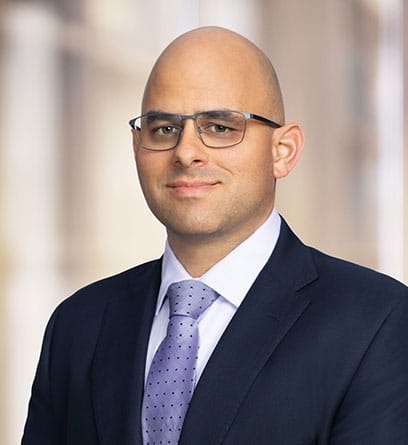After you’ve read this article, please see the latest article in this series, Part III: Another update on IPR estoppel in the Courts and at the PTAB, which provides an update on IPR estoppel through April 2018.
Inter partes review (IPR) proceedings continue to be as popular as ever. Filings before the Patent Trial and Appeal Board (“Board”) are up year-over-year, and the trend doesn’t appear to be slowing. While the advantages of these proceedings far outweigh the disadvantages for petitioners, one small downside is estoppel under 35 U.S.C. § 315(e), which can potentially prevent certain invalidity defenses at trial if the IPR isn’t successful. Back in March, I reported on a number of contradictory district-court cases interpreting this estoppel effect — some finding broad estoppel under the statute, with others interpreting it very narrowly. See The shifting standard for IPR estoppel: Where are we now? While the district split has not been resolved in the seven months since that article, a number of new cases have been decided, further developing the case law.
Background
As previously explained, the Federal Circuit has arguably taken a very narrow interpretation of § 315(e). See, e.g., Shaw Indus. Group, Inc. v. Automated Creel Systems, Inc., 817 F.3d 1293, 1299-1300 (Fed. Cir. 2016). In these cases, the Federal Circuit confronted situations where the Board instituted IPR on some (but not all) grounds raised in a petition. The Federal Circuit indicated that estoppel does not apply to such non-instituted prior art. “As we explained supra, however, the non-instituted grounds do not become a part of the IPR. Accordingly, the non-instituted grounds were not raised and, as review was denied, could not be raised in the IPR. Therefore, the estoppel provisions of § 315(e)(1) do not apply.” HP Inc. v. MPHJ Tech. Inv., LLC, 817 F.3d 1339, 1347-48 (Fed. Cir. 2016) (citing Shaw, 817 F.3d at 1299-1300). This is a quite literal interpretation of the statute, which refers to grounds that the petitioner “raised or reasonably could have raised during that inter partes review” (as opposed to those that were raised or could have been raised in a petition for inter partes review).
District courts, however, have interpreted Shaw and HP differently, and thus have come to different conclusions as to whether estoppel under 35 U.S.C. § 315(e) is “narrow” or “broad.”
Narrow estoppel
At least two district-court judges have literally interpreted Shaw and HP, giving them broad effect. See Intellectual Ventures I LLC v. Toshiba Corp., 2016 WL 7341713, at *12-13 (D. Del. Dec. 19, 2016), denying reconsideration, 2017 WL 107980, *1 (D. Del. Jan. 11, 2017). Under this interpretation, in addition to non-instituted art not being estopped, prior art not raised before the Board in the petition in the first instance is also not estopped. This follows because in instituting an IPR, the Board typically limits the proceeding to specific claims and specific prior art. The petitioner is not typically allowed to raise other grounds based on different prior art. Thus, after the Board renders its judgment (in a final written decision), it logically can be said that the petitioner couldn’t have raised any other art during the actual IPR, and thus such other art isn’t estopped. See also Verinata Health, Inc. v. Ariosa Diagnostics, Inc., 2017 WL 235048, at *3-4 (N.D. Cal. Jan. 19, 2017).
Broad estoppel
At least one district court has attempted to limit Shaw and HP as much as possible. See Biscotti Inc. v. Microsoft Corp., Case No. 2:13-CV-01015-JRG-RSP, 2017 WL 2526231, at *7 (E.D. Tex. May 11, 2017). In this case, the Eastern District of Texas found that Shaw provides only a very narrow exception to estoppel. Under this interpretation, anything that was or could have been raised in a petition is estopped, except for art that actually was raised and then rejected by the Board for purely procedural reasons, such as redundancy. Estoppel, however, applies to art that was raised but rejected on the merits, as well as art that wasn’t raised in the petition but could have been.
Other district courts, too, have narrowly interpreted Shaw and HP, but not quite to the extent as the Eastern District of Texas. These courts apply the Shaw exception to grounds raised in the petition but not instituted by the Board regardless of the reason for the non-institution, whether procedural or on the merits. See Oil-Dri Corp. of America v. Nestle Purina Petcare Co., No. 15-cv-1067, 2017 WL 3278915 (N.D. Ill. Aug. 2, 2017); see also Milwaukee Electric Tool Corp. v. Snap-On Inc., No. 14-CV-1296, 2017 WL 4220457, at *25 (E.D. Wis. Sept. 22, 2017).
Other courts have found for broad estoppel, but without explicitly deciding whether the reason for non-institution matters. One case, in particular, is noteworthy in that it potentially broadens estoppel, although in a different manner than discussed above. See Douglas Dynamics, LLC v. Meyer Products LLC, 14-CV-886, 2017 WL 1382556 (W.D. Wis. Apr. 18, 2017), reconsideration granted in part, 2017 WL 2116714 (May 15, 2017). In this case, the Western District of Wisconsin, in a motion for reconsideration, found that a defendant is not limited to the exact grounds raised in the IPR petition (which were not instituted). However, the court indicated that a defendant is not able to make entirely new arguments based upon the prior art rejected by the Board. That is, the defendant is limited to the general theories raised in the petition. But entirely new theories, even if based upon the same prior art (e.g., that rely on different, uncited portions of the art or rely on entirely different claim constructions), would rise to the level of being a new ground, according to the court, for which estoppel would apply. Where exactly that line is drawn, however, was not answered by the Douglas Dynamics court. Instead, the court deferred on the specific issue in that case and indicated it would decide later on summary judgment after further briefing.
Conclusion
For now, the scope of estoppel under 35 U.S.C. § 315(e) is heavily reliant upon the district and the particular judge to which the case is assigned. It, however, is only a matter of time before the issue reaches the Federal Circuit and the standard is clarified. Until then, best practices dictate that petitioners should err on the side of caution and assume that anything that could have been raised in the petition will be estopped in district court. Said another way, petitioners should put forth their best arguments in the IPR petition.
Tony Blum represents clients before the USPTO in post-grant proceedings and litigates patent infringement suits throughout the country.


